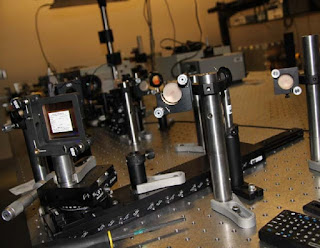Nanophotonic Equipment market was valued at xx Million US$ in 2018 and is projected to reach xx Million US$ by 2025, at a CAGR of xx% during the forecast period. In this study, 2018 has been considered as the base year and 2019 to 2025 as the forecast period to estimate the market size for Nanophotonic Equipment.
 |
| Nanophotonic Equipment |
Development of Nanophotonic equipment/devices deals with the design, fabrication and characterization of nanophotonic technology across various nanophotonic application. Current research & development is majorly focused on developing nanophotonic equipment for applications such as telecommunication, consumer electronics and healthcare.
Among all regions, North America followed by Western Europe is anticipated to dominate the market due to continuous focus on commercializing nanophotonic technology into various applications.
This report presents the worldwide Nanophotonic Equipment market size (value, production and consumption), splits the breakdown (data status 2014-2019 and forecast to 2025), by manufacturers, region, type and application.
This study also analyzes the market status, market share, growth rate, future trends, market drivers, opportunities and challenges, risks and entry barriers, sales channels, distributors and Porter's Five Forces Analysis.
The following manufacturers are covered in this report:
- Nanonics Imaging
- Cambridge Display
- Samsung
- Osram
- IBM
- Philips
- Novaled GmbH
- Hitachi
- General Electric
- Covega Corporation
Nanophotonic Equipment Breakdown Data by Type
- Nano-Ribbons
- Quantum Dots
- Nano-Tubes
- Photonic Crystals
- Plasmonics
- Others
Nanophotonic Equipment Breakdown Data by Application
- Telecommunication
- Healthcare
- Consumer Electronics
- Automotive
- Others
Report Sample includes:
- Table of Contents
- List of Tables & Figures
- Charts
- Research Methodology
Get FREE Sample of this Report at https://www.24marketreports.com/report-sample/global-nanophotonic-equipment-2025-300
- Table of Contents
- List of Tables & Figures
- Charts
- Research Methodology
Get FREE Sample of this Report at https://www.24marketreports.com/report-sample/global-nanophotonic-equipment-2025-300
Nanophotonic Equipment Production by Region
- United States
- Europe
- China
- Japan
- South Korea
- Other Regions
Nanophotonic Equipment Consumption by Region
- North America
- United States
- Canada
- Mexico
- Asia-Pacific
- China
- India
- Japan
- South Korea
- Australia
- Indonesia
- Malaysia
The study objectives are:
- To analyze and research the global Nanophotonic Equipment status and future forecast?involving, production, revenue, consumption, historical and forecast.
- To present the key Nanophotonic Equipment manufacturers, production, revenue, market share, and recent development.
- To split the breakdown data by regions, type, manufacturers and applications.
- To analyze the global and key regions market potential and advantage, opportunity and challenge, restraints and risks.
- To identify significant trends, drivers, influence factors in global and regions.
- To analyze competitive developments such as expansions, agreements, new product launches, and acquisitions in the market.
In this study, the years considered to estimate the market size of Nanophotonic Equipment :
- History Year: 2014 - 2018
- Base Year: 2018
- Estimated Year: 2019
- Forecast Year: 2019 - 2025
This report includes the estimation of market size for value (million USD) and volume (K Units). Both top-down and bottom-up approaches have been used to estimate and validate the market size of Nanophotonic Equipment market, to estimate the size of various other dependent submarkets in the overall market. Key players in the market have been identified through secondary research, and their market shares have been determined through primary and secondary research. All percentage shares, splits, and breakdowns have been determined using secondary sources and verified primary sources.
For the data information by region, company, type and application, 2018 is considered as the base year. Whenever data information was unavailable for the base year, the prior year has been considered.
Get the Complete Report & TOC at https://www.24marketreports.com/semiconductor-and-electronics/global-nanophotonic-equipment-2025-300
No comments:
Post a Comment